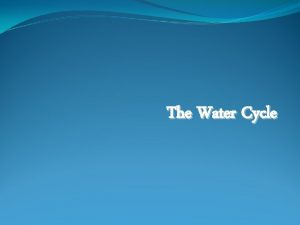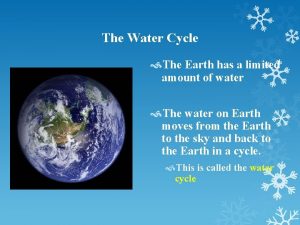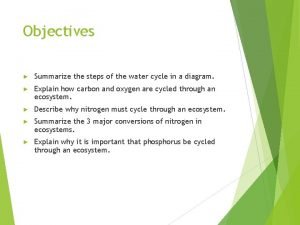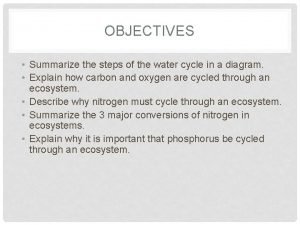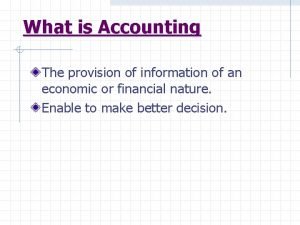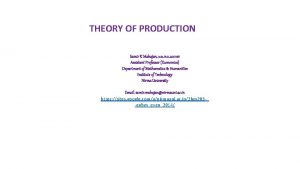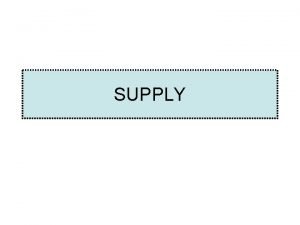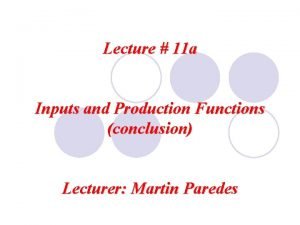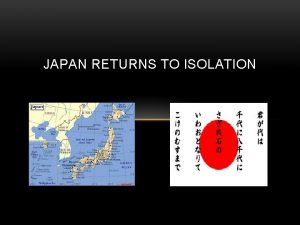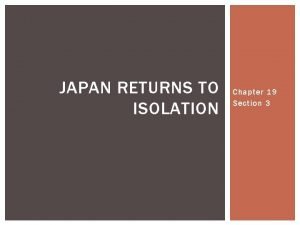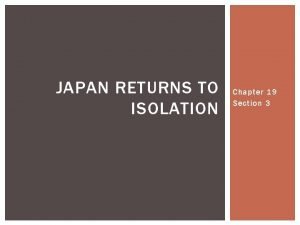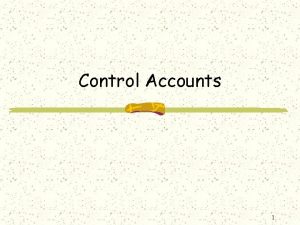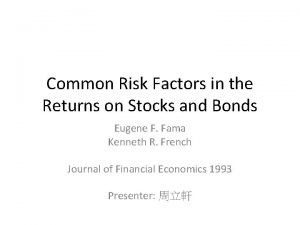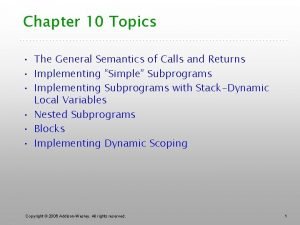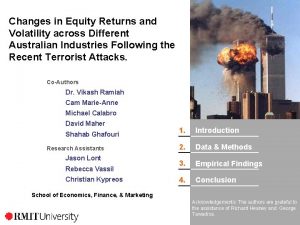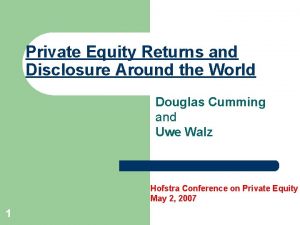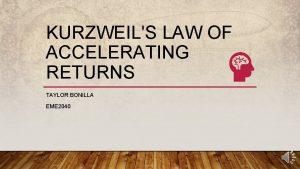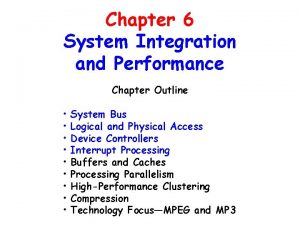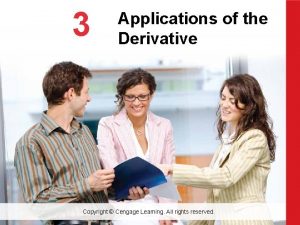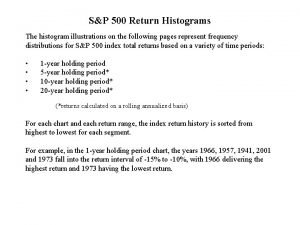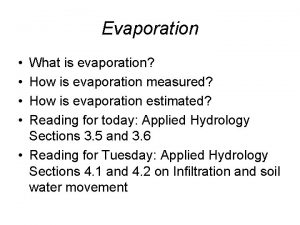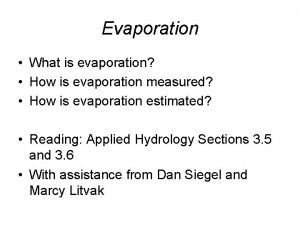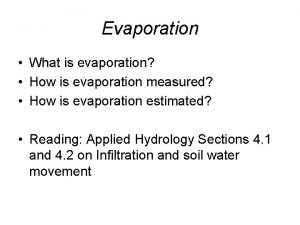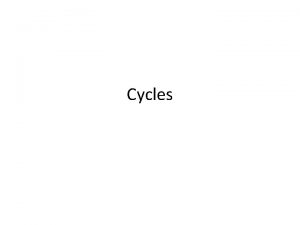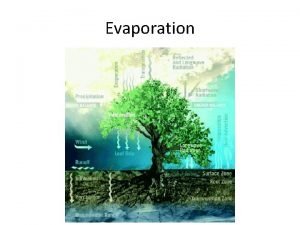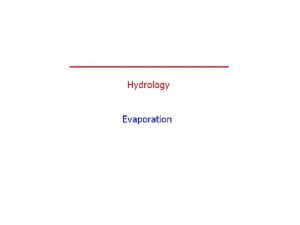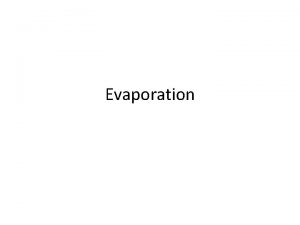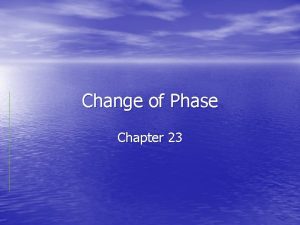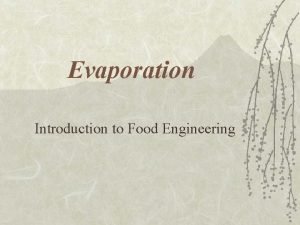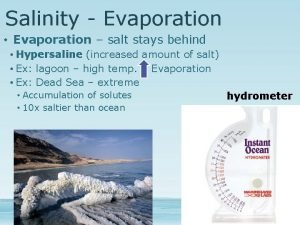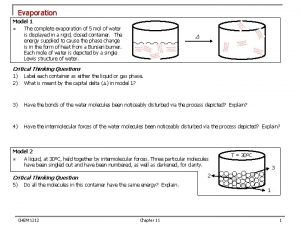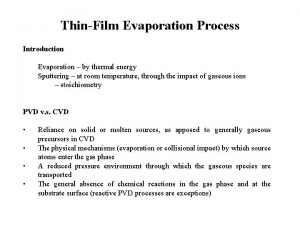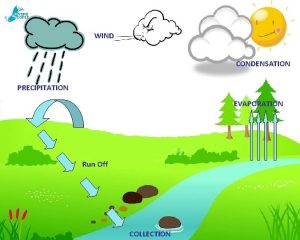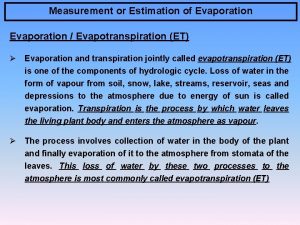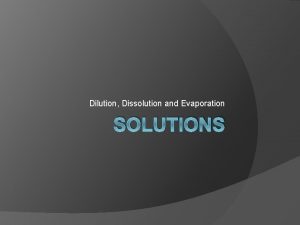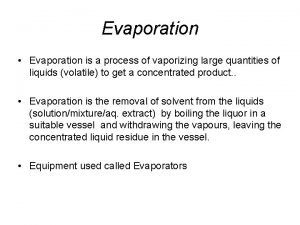Water Cycle 5 steps Evaporation Water returns to





























- Slides: 29

Water Cycle • 5 steps

Evaporation • Water returns to the atmosphere from lakes, rivers, etc in the form of vapor.

Transpiration • Water returning to the atmosphere in the form of vapor from plants

Condensation • Water vapor becomes liquid in the form of clouds

Precipitation • Liquid water from clouds falls back to Earth as rain, sleet, hail, and snow.

Run Off • Water from precipitation flows back into lakes and rivers.

Carbon Cycle • Carbon cycles from the atmosphere to organisms and back

Carbon Short Term Cycle • Plants convert CO₂ in the air into carbohydrates during photosynthesis. • Consumers eat producers • Consumers obtain carbon from the carbohydrates. • Consumers release carbon as CO₂ into the atmosphere.

Carbon Long Term Cycle • Carbon is converted into carbonates (bones, shells) • Some carbohydrates are converted to fats, oils • Carbon is released into atmosphere through the death of carbon-containing organisms • Deposits of dead organisms fossil fuels

Carbon cycle • http: //www. windows 2 universe. org/earth/cli mate/carbon_cycle. html • http: //www. kscience. co. uk/animations/carb on_cycle. swf • Brain Pop Carbon Cycle: https: //www. brainpop. com/science/earthsyst em/carboncycle/

Photosynthesis • Plants use carbon in carbon dioxide from the atmosphere to make glucose.

Consumption • Consumers get carbon from glucose by eating plants for energy.

Cell Respiration • Carbon is returned to the atmosphere as carbon dioxide when consumers breath out.

Fossil Fuels • Carbon from dead organisms decays into petroleum in the ground (fossil fuels)

Burning Fossil Fuels • We burn fossil fuels (gas, oil, coal) and release the trapped carbon as carbon dioxide into the atmosphere.

Nitrogen Cycle • Some organisms use nitrogen to make proteins. • Almost 80% of air is made of nitrogen, but it is in a form we cannot use (N 2).

Nitrogen Cycle • Humans affect the nitrogen cycle by burning fossil fuels. • This releases nitric oxide into the atmosphere, which combines with oxygen and water vapor to form nitric acid. • Nitric acid can dissolve in rain and snow, leading to acid rain.

Nitrogen Fixation • Lightning and some bacteria that live in soil and roots can turn nitrogen from the air into a form plants can absorb.

Consumption • Consumers get nitrogen by eating

Ammonification • Ammonification is when consumers release waste, returning nitrogen to the soil in the form of ammonia. N N

Denitrification • Some bacteria break down ammonia and return nitrogen to the atmosphere.

Nitrogen Cycle • Nitrogen Cycle Brain Pop: https: //www. brainpop. com/science/earthsyst em/nitrogencycle/

Phosphorus Cycle • Phosphorus forms bones, teeth • Plants get phosphorus from soil and water • Animals get phosphorus from eating plants and other animals that have eaten plants • This is a slow cycle and doesn’t include the atmosphere (air) • Phosphorus rarely occurs as a gas • How does phosphorus enter soil and water?

PHOSPHORUS CYCLE

PHOSPHORUS CYCLE

Fertilizers • Fertilizers contain nitrogen and phosphorus • Enters ecosystem as runoff • This causes the Rapid growth of algae, called algal blooms • Algal blooms and bacteria rob aquatic ecosystems of oxygen. (This is BAD)

Cycles: Video Clip • http: //local. brookings. k 12. sd. us/biology/PH Videos/Chapter%2003. mpg

Greenhouse Effect • CO 2 is needed for photosynthesis and capturing warmth radiating from earth • But, too much CO 2 is released from organisms, volcanoes, and burning of fossil fuels. • Causes buildup of CO 2, which traps sunlight, and causes warming and climate changes.

GREENHOUSE EFFECT • Example of humans changing the environment by the constant adding of CO 2 to our atmosphere • Does not allow the heat from the sun to radiate back out into space. • This capturing of heat is called the greenhouse effect. • Caused by volcanic eruptions, burning of fossil fuels, other pollutants.
 Evaporation water cycle
Evaporation water cycle Water and water and water water
Water and water and water water Water molecule evaporation
Water molecule evaporation Transpirasi adalah
Transpirasi adalah Four steps of water cycle
Four steps of water cycle Summarize the steps of the water cycle.
Summarize the steps of the water cycle. Summarize the water cycle
Summarize the water cycle Brain pop water cycle
Brain pop water cycle Water cycle the hydrologic cycle
Water cycle the hydrologic cycle What is bookkeeping
What is bookkeeping Returns outwards
Returns outwards Law of returns to scale
Law of returns to scale Stage of negative returns
Stage of negative returns The function sum( region= sales) returns
The function sum( region= sales) returns Conclusion of production
Conclusion of production Japan returns to isolation
Japan returns to isolation Chapter 19 section 3 japan returns to isolation
Chapter 19 section 3 japan returns to isolation Chapter 19 section 3 japan returns to isolation
Chapter 19 section 3 japan returns to isolation Mmap returns ffff
Mmap returns ffff What is sectional balancing
What is sectional balancing Common risk factors in the returns on stocks and bonds*
Common risk factors in the returns on stocks and bonds* Sales returns entry
Sales returns entry General semantics of calls and returns
General semantics of calls and returns How to calculate abnormal returns
How to calculate abnormal returns Private equity returns and disclosure around the world
Private equity returns and disclosure around the world Persepolis chapter 17 summary
Persepolis chapter 17 summary Law of accelerating returns
Law of accelerating returns Law of diminishing returns
Law of diminishing returns Point of diminishing returns calculus
Point of diminishing returns calculus Histogram of returns
Histogram of returns
